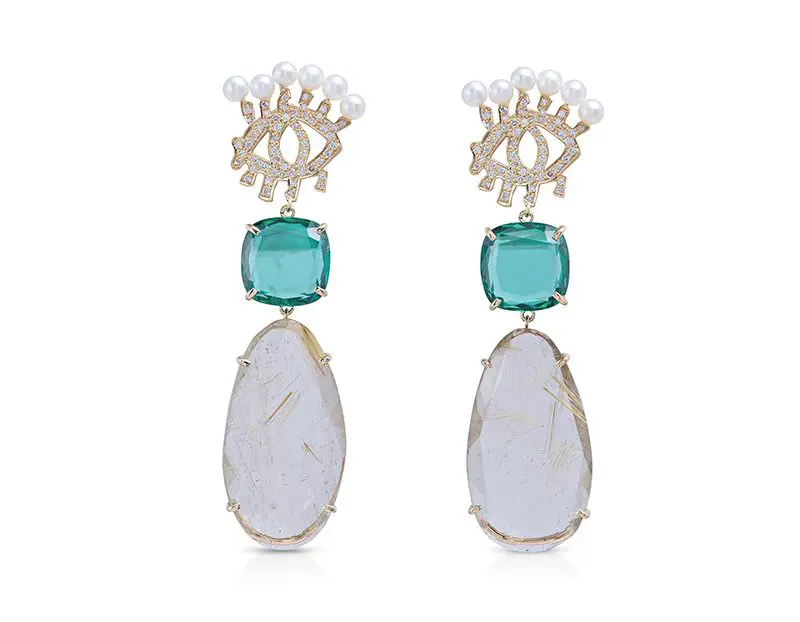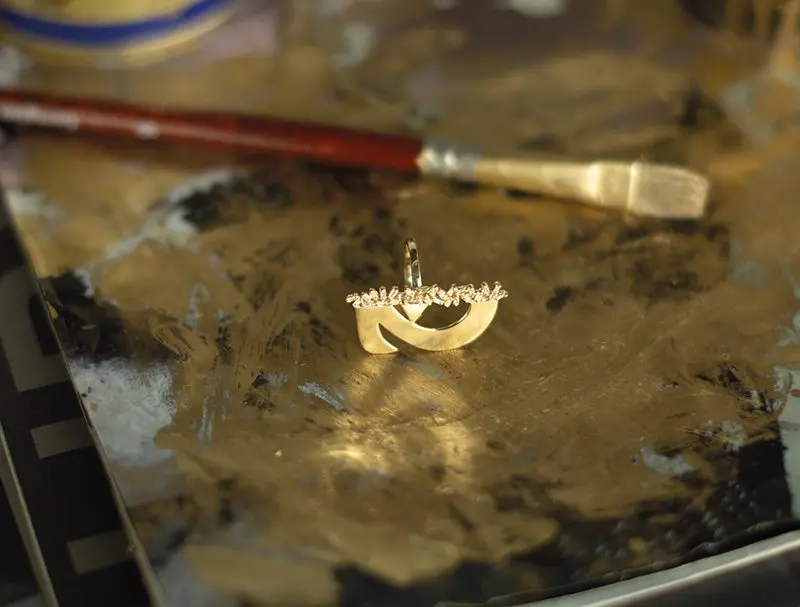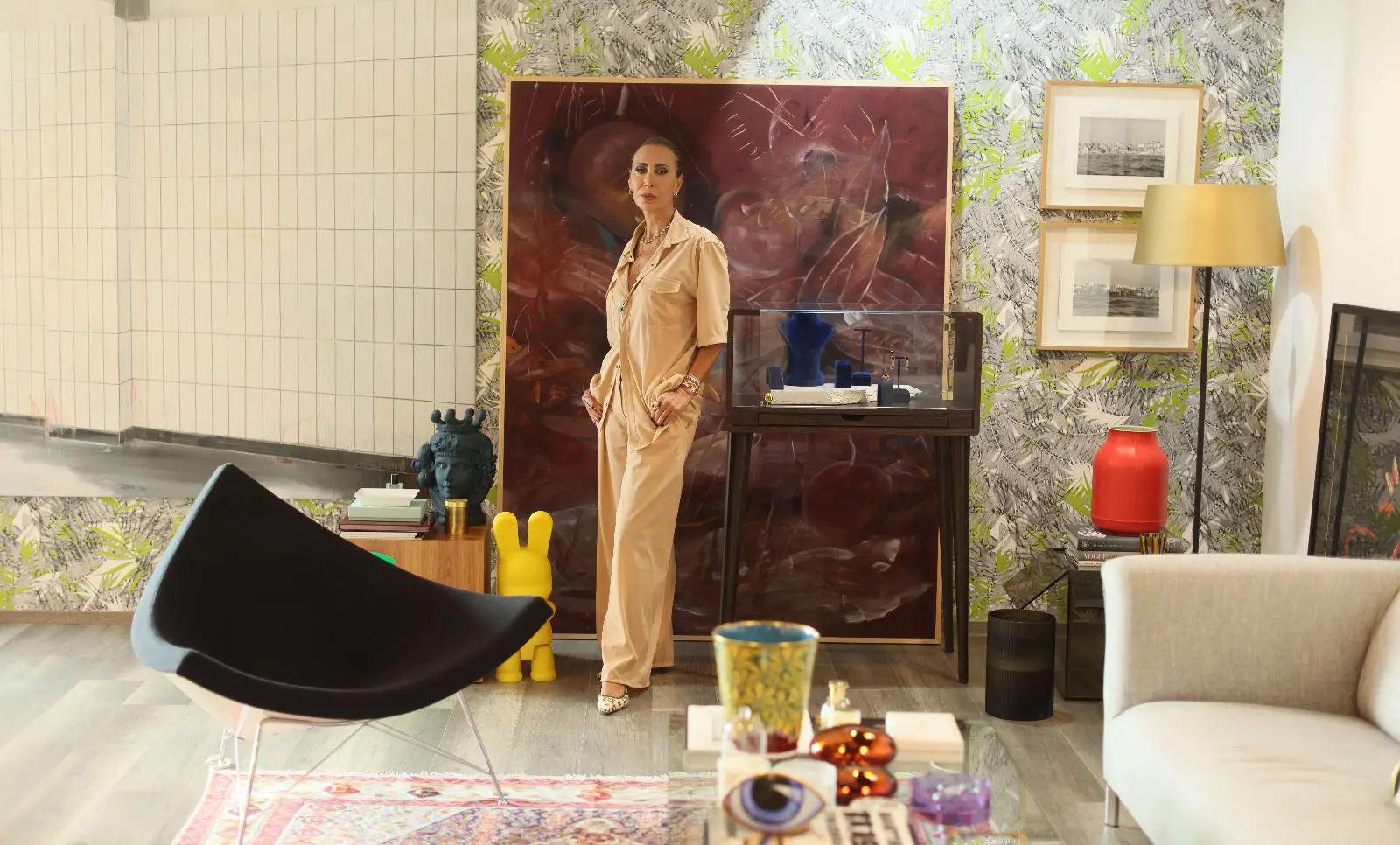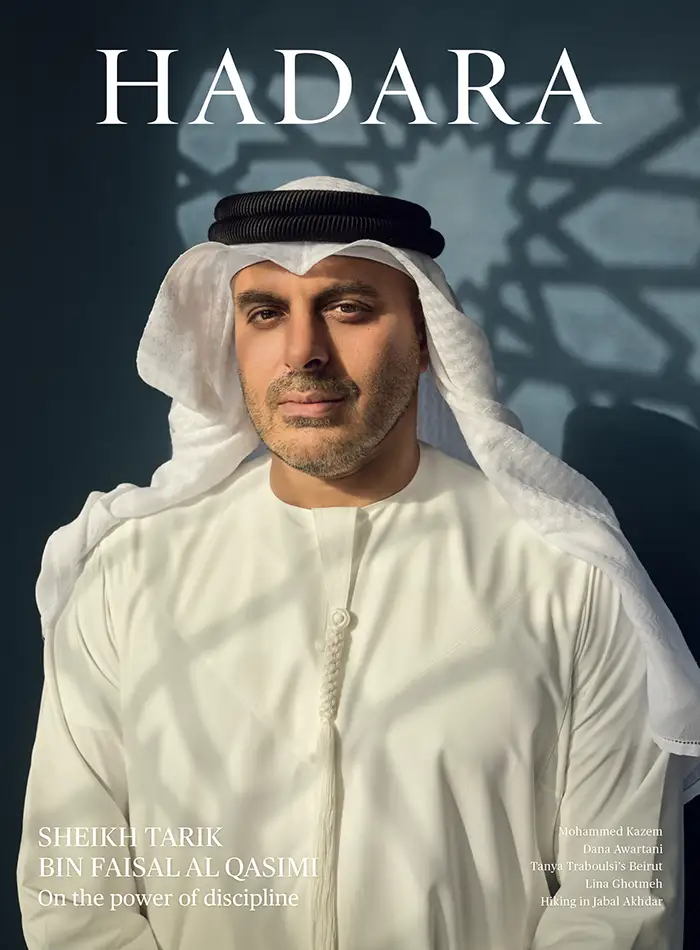An ode to identity
Crafted with love and inspired by heritage, jewellery designer Nadine Kanso creates wearable art.
By Nicola Chilton
PHOTOGRAPHS BY RUDOLF AZZI
Nadine Kanso makes a statement with maximalism, sparkling with pieces from her jewellery brand, Bil Arabi. Her ears are studded with gold and diamonds. Oversized rings adorn her fingers. A stack of bracelets jangles on each wrist. Multiple necklaces hang from her neck. On anyone else it might look overdone, but Kanso manages to hit the perfect balance.
Born in Lebanon, Kanso moved to Dubai 25 years ago. She established Bil Arabi in 2006, crediting the positivity and vision of her chosen home with giving her the drive to create. “It’s a place that grows on you, and you become part of it,” she says when we meet in her studio in Dubai Design District. The brand was born out of a desire to move away from a stereotypical view of the Arab world and to reclaim Arab identity. “Our purpose with Bil Arabi is very clear,” she says. “I want to tell the world that we should be proud of who we are, our heritage, our culture, and our language.”
The brand releases one major collection a year—10 to 15 pieces designed to reflect the stories Kanso wants to tell. Smaller drops in between allow for the unscripted exploration of ideas and inspirations. Signature pieces are permanently available; others are created in limited editions or as one-of-a-kind pieces for collectors. Mass production is not an option. “Everything is created with precision and a deep respect for craftsmanship,” she says.
Kanso’s first pieces for Bil Arabi, featuring Arabic letters and positive words, are still the designs that define the brand. She credits her Hobb collection, “love” in Arabic, as having taken Bil Arabi to the next level. “I’m happy to spread love. I think with love you find peace, so hopefully that has a positive impact for everyone,” she says. In some of her pieces, the words are stretched to become an abstract form rather than readable letters. The calligraphy is there, but also not there, like a secret message known only by the wearer. Kanso feels that simply wearing positive words has a positive impact, especially if the wearer is Arab. “It becomes a conversation starter and adds another layer on the story of where we come from,” she says.
Kanso’s designs have evolved to include cultural references in addition to the calligraphic collections. “For the last three to four years I’ve designed more pieces with eyes and hearts,” she says. Her new collection, Najlaa, launched in September, a sub-collection of the broader Ya Ein line, reflects that. Inspired by Arabic poetry, the collection centres on the eye motif that runs through many Arab and Mediterranean cultures. “Najlaa” describes a woman with wide, expressive eyes; it is also the name of Kanso’s grandmother, a long-time inspiration. “I cut the eye in half, used emeralds and topaz, and added pearls on the lashes. The matte gold finishing has a Roman or Greek appeal to it,” she says. “The eye is a big part of the brand and we’re putting it more at the forefront to have a balance of calligraphy and something cultural that can travel outside the region.”

Nadine Kanso makes a statement with maximalism, wearing pieces from her jewellery brand, Bil Arabi. Here she wears a TAIM ring with purple amethyst and HOBB and OULA cuffs.
Kanso’s own artistic eye is evident everywhere in her studio, from her photography of her beloved Beirut and Dubai to her design collaborations with carpetmaker Iwan Maktabi and furniture designer Fadi Sarieddine. “The world inspires me, life inspires me, love inspires me, just being alive inspires me,” she says. A trophy cabinet contains awards, sketches and books, as well as Kanso’s 2023 collaboration with Guerlain to celebrate the 170th anniversary of the parfumier’s iconic bee bottle, originally designed for the wedding of Empress Eugénie and Napoleon III. Kanso, the first Arab female designer to work with the Paris perfume house, covered the bottle in her trademark Arabic calligraphy made from 24-karat gold and 1,710 Swarovski crystals. “The collaboration with Guerlain not only elevated Bil Arabi, but also gave hope to other Arab designers to believe that if they work hard, there will be appreciation somewhere,” she says.
Kanso’s studio is also a showcase for her jewellery, including archival pieces like The City and the Birds, a one-off rose-gold cuff with pink and blue sapphires, featuring the forms of flamingos and the Burj Khalifa, created for the inaugural Dubai Design Week. In the cabinet next to it are sculptural pieces from the Dia collection, inspired by shadows and looking like curls of ribbon rendered in gold, but based on Arabic letters. Alongside these are bold, colourful pieces from the Hawa collection, reminiscent of modernised heritage pieces with the word “Hobb” rendered in intricate detail, inspired by the mashrabiya of traditional Arab architecture. A stack of old vinyls on one wall forms an art piece inspired by Kanso’s late uncle, Khaled, and made from his record collection.
Kanso helped move jewellery-making to an art form, with her modern designs, bold yet reflective, an ode to modern Arab identity. She’s optimistic about the next generation of Arab designers. “There is so much talent in the Arab world right now,” she says. “I admire designers who are bold in expressing their identity and redefining what Arab creativity means. One designer I particularly admire is Mrs. Keepa, her work is so innovative. It’s exciting to see this new wave of talent reshaping the design landscape.”
At the heart of Bil Arabi is Kanso’s commitment to her roots, her culture and heritage, and to using it as a force for good in the world. “I always say that if you don’t have a past, you don’t have a present,” she says. “And if you don’t have a present, you definitely don’t have a future.”


Top, YA EIN, 18K gold and white diamond earrings from the Najlaa collection, released in September. Inspired by Arabic poetry, the collection centres on the eye motif that runs through many Arab and Mediterranean cultures. Above, a ring from the OULA collection. Earrings: Courtesy of Bil Arabi; Ring courtesy of Berluti.



